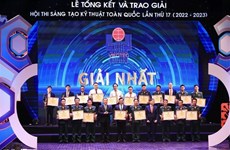Telecom companies enter bidding race for 5G rights
Vietnam's telecom companies on March 7 entered a bidding race over the rights to develop and exploit the country's 5G 2500-2600 MHz band for the next 15 years.
 Telecom workers perform a test on 5G mobile networks in Hoan Kiem district, Hanoi (Photo: VNA)
Telecom workers perform a test on 5G mobile networks in Hoan Kiem district, Hanoi (Photo: VNA)The band, officially designated as B1 during the bidding, had a starting price of 3.9 trillion VND (158 million USD).
Speaking at the event, Deputy Minister of Information and Communications Nguyen Huy Dung said the bidding is a historic day for the telecom sector and the commercialisation of 5G in Vietnam.
Minister of Information and Communications Nguyen Manh Hung said the ministry's 5G policy remained open, allowing all eligible enterprises to participate in the auction, not just mobile network providers offering new 5G services. In the event a business wins a bid for the 5G frequency, it will subsequently be granted a licence to provide mobile services.
While any company could participate in the 5G frequency auction, industry experts said it would be extremely challenging for new players to enter the 5G game, and it was almost a given that the winners would be among the existing mobile service providers.
It is expected that new players must invest up to 1 billion USD in network infrastructure to make use of 5G technologies. It is said to be very unlikely as the country's mobile market has long reached saturation. In addition, voice calls and SMSs, traditionally strong sources of income for telecom companies, have been on the decline.
In recent years, telecom companies have reported dwindling profits as the market sees increasingly fierce competition, which has discouraged new players from joining.
In an earlier interview with the press, Hung said the MIC had picked this year to roll out the commercialisation of 5G nationwide. He stressed the importance of 5G, citing China Mobile as a successful example of an early adopter of the technology. The group, after investing nearly 4 billion USD in developing 5G and creating more than 30,000 industrial-use applications, had reported over 10 per cent growth in annual revenue.
For example, factory workers in China had started using 5G-enabled cameras equipped with SIM cards to capture images of standard circuit boards, which were then sent to data centres for AI analysis to identify faulty components. This simple and elegant solution had both enhanced efficiency and contributed to improved accuracy and productivity.
Hung said while a 10% growth rate in revenue could not be accomplished without 5G, the technology must be developed into an ecosystem to realise its full potential.
According to the MIC, Vietnam has set a target to provide 5G coverage to 99% of the country's residents by the year 2025 at 100 Mbps speed.
Representatives from Ericsson Vietnam said 5G could be seen as a complete digital infrastructure, which could replace physical infrastructure in the future. 5G digital infrastructure not only could connect people to people, but also people to machines, and machines to machines.
Nguyen Van Son, Director of Viettel Telecom's Mobile Centre, said that while there was a high demand for 5G among the population, the number of devices supporting 5G still remained low, accounting for only 17-20%. He said that given the circumstances, Viettel had plans to deploy 5G in areas with high demand and a high percentage of 5G-compatible phones, which includes industrial zones, export processing zones and innovation centres.
Two other 5G bands, 3700-3800 MHz (C2) and 3800-3900 MHz (C3), both with a starting price of 1.89 trillion VND are next to go up for auction on March 14 and March 19./.













